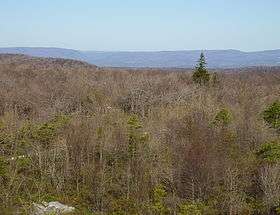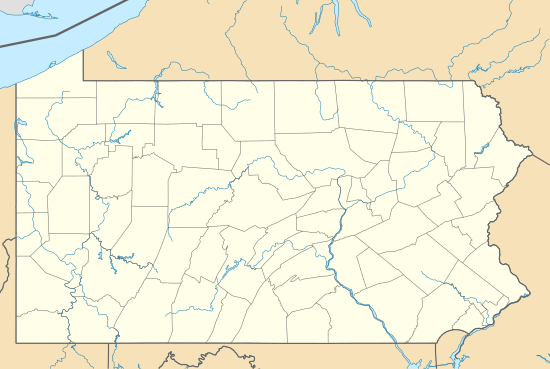Negro Mountain
| Negro Mountain | |
|---|---|
 View west from Negro Mountain highpoint | |
| Highest point | |
| Elevation | 3,213 ft (979 m) |
| Coordinates | 39°47′10″N 79°10′30″W / 39.78611°N 79.17500°WCoordinates: 39°47′10″N 79°10′30″W / 39.78611°N 79.17500°W |
| Geography | |
 Negro Mountain Location of Negro Mountain in Pennsylvania | |
| Location | Somerset County, Pennsylvania / Garrett County, Maryland, U.S. |
| Parent range | Allegheny Mountains |
| Topo map | USGS Markelton, Meyersdale (PA) Quadrangle |
| Climbing | |
| First ascent | Unknown |
| Easiest route | Drive up |
Negro Mountain is a 30-mile (48 km) long ridge of the Allegheny Mountains extending from Deep Creek Lake in Maryland, north to the Casselman River in Pennsylvania, United States. The summit, Mount Davis, is the highest point (3,213 feet) in Pennsylvania.[1] Laurel Hill flanks Negro Mountain to the west, with Allegheny Mountain to the east.
Geography and climate
The mountain is flattish in appearance due to its location on the Allegheny Plateau, so its prominence is of low relief. The mountain retains its elevation above 3,000 feet (910 m) for much of its length, especially in Pennsylvania. The Negro Mountain Tunnel, built for the South Pennsylvania Railroad, is abandoned and was never used. The Mount Davis Natural Area on the Mountain is located within the Forbes State Forest and many trails take hikers throughout this alpine landscape.
Weather on the mountain is fierce, frost can occur at any time of the year and winds and ice storms are common. Near the summit in Pennsylvania, the trees are stunted and circular rock formations from frost heave can be readily seen.
History
Details behind the naming of Negro Mountain are not precisely known and a number of local stories have circulated in the past. The various stories seem to share, however, a couple of elements. One is that of a band of white soldiers or hunters skirmishing with Indians on the mountain during colonial times. The other is the presence with the whites of an African-American companion — variously named "Nemisis" [sic] or "Goliath" indicating his great strength or size — who accompanied the whites and died valiantly during the fight. The most popular version of the story[2] takes place during the French and Indian War, in the year 1756, when frontiersman Colonel Thomas Cresap is known to have led a force against Native Americans on the mountain. A member of his force, a black slave or a scout named "Nemisis," was killed in the battle. The mountain was accordingly named "Negro Mountain" in his honor.[3]
Another version of the story has a Captain Andrew Friend on a hunting trip on the mountain with a few companions. The party was attacked by Indians and during the ensuing skirmish, an African-American servant of Friend was gravely wounded and died the following morning on the mountain. Again, the mountain where he died defending the life of his master was named in his honor.[4]
Yet another version, this time from local family lore, tells of:
John Hyatt, one of the early settlers, [who] was a native of Maryland. He came with several others, accompanied by a number of slaves, to Turkey-Foot [Township] soon after the settlement began. While crossing the Negro mountain, a party of Indians fired upon them and mortally wounded one of the negroes, the strongest man in the company. A piece of a hollow log was found and placed over the negro to shelter him. Throwing it off, he said, "Save yourselves and never mind me; I shall die soon." It is said that Negro Mountain took its name from this circumstance.[5]
The Cresap version is supported by the fact that Cresap is known to have written an account of such an expedition for Benjamin Franklin's Pennsylvania Gazette of June 17, 1756 mentioning that "an old Negro presented his gun at [the Indians]". The Maryland Gazette had already described the same expedition on June 10, 1756, mentioning that a "free Negro" had been killed with the English.
Controversy
In July 2007, Pennsylvania State Representative Rosita C. Youngblood (Democrat of Philadelphia’s 198th District) called for the renaming of Negro Mountain. In a news release, she said, "Through a school project, my son and granddaughter first informed me of the name of this range and I found it to be disparaging that we have one of our great works of nature named as such… I find it disheartening for tourists who visit this range to see the plaque with the name Negro Mountain displayed on the mountainside."[6][7]
However, Professor Christopher Bracey, a law professor and associate professor of African and African-American studies at Washington University in St. Louis has said, "I must confess I have a slightly different take on it than [Youngblood]… Here we have a mountain, whose name was intended to be a testament to Negro bravery. It seems rather crass and unsophisticated to name it Negro Mountain, but the intentions were strong."[6][7]
On 1 August 2007, Youngblood and other lawmakers introduced House Resolution No. 378 [8] resolving that the governor "form a commission …to study the naming of Negro Mountain and Mount Davis …[to] adopt names that accurately reflect the history of the region and the heroism displayed by the African American in the Negro Mountain conflict of 1756" and accordingly to alter "brochures, plaques and signs [to] accurately reflect the facts of this heroic historical event". (The 1921 naming of Mount Davis is now also considered controversial because it honors the white settler who once owned the land, rather than the colonial African-American.[8])
In February 2011, nine Maryland State Senators introduced a bill to rename Negro Mountain and Polish Mountain.[3][9] All four Western Maryland representatives testified against the proposed bill, which was voted down in committee.[10]
References
- ↑ Cohen, Saul B. (2000). The Columbia Gazetteer of North America; Entry: Negro Mountain. New York: Columbia University Press. p. 1157. ISBN 0-231-11990-9.
- ↑ Scharf, J. Thomas (1882), History of Western Maryland.
- 1 2 "Md. bill seeks to rename Negro, Polish mountains". WTOP.com. Retrieved 14 March 2011.
- ↑ Blackburn, E. Howard, William H. Welfley and William H. Koontz (1906) The History of Bedford and Somerset Counties, Volume 2, Chapter 4.
- ↑ "History of Lower Turkey-Foot Township, Somerset County". PAGenWeb, The USGenWeb Project. Retrieved 2009-02-08.
- 1 2 Interview, 13 July 2007, Philadelphia Daily News
- 1 2 Bracey, Christopher (8 August 2006). "Some Thoughts on Negro Mountain". Archived from the original on February 6, 2009. Retrieved 2009-02-08.
- 1 2 "House Resolution No. 378; Session of 2007". The General Assembly of Pennsylvania. 1 August 2007. Retrieved 2009-02-08.
- ↑ Julie Bykowicz (February 21, 2011). "'Negro Mountain' called an honor, others see racism". The Baltimore Sun. p. 1.
- ↑ Bieniek, Matthew (14 April 2011). "Rocky Gap, alcohol licensing bills passed legislature this session". Cumberland Times-News. Retrieved 27 April 2011.
Other sources
- Wynn, Anita (2006), "The Story of Nemisis and Negro Mountain: How Far Should You Go in Reading a Public Sign?", Anthropology News, Vol. 47 Issue 7, pp 18–19; (Published Online: 24 Dec 2008); American Anthropological Association; doi:10.1525/an.2006.47.7.18.
- Bykowickz, Julie, "Controversy over 'Negro Mountain' reveals urban-rural divide" Baltimore Sunpaper (Published Online: 21 February 2011)
External links
| Wikimedia Commons has media related to Negro Mountain. |
- "Forbes State Forest". Pennsylvania Department of Conservation and Natural Resources. Retrieved 2006-07-12. Note: As of July 2006, this web page has not been updated to reflect the Pennsylvania State Forest Districts realignment.
- Video Story of Negro Mountain
- Negro Mountain historical marker